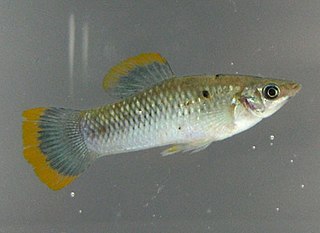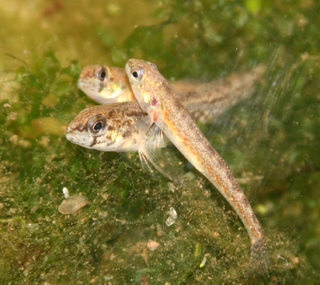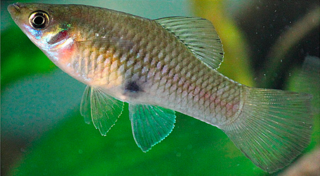
The bluegill, sometimes referred to as "bream," "brim," "sunny," or "copper nose" as is common in Texas, is a species of North American freshwater fish, native to and commonly found in streams, rivers, lakes, ponds and wetlands east of the Rocky Mountains. It is the type species of the genus Lepomis, from the family Centrarchidae in the order Perciformes.

The sailfin molly is a species of fish in the genus Poecilia. As with the other types of mollies, P. latipinna is a livebearer, giving birth to free-swimming babies, a trait they share with similar fish species such as guppies, platies and swordtails. Sailfin mollies typically inhabit both freshwater and brackish waterways along the East Coast of the United States, from North Carolina south to Florida, and around the Gulf of Mexico to Texas, and south to the Yucatán Peninsula of México. Given their preference for more brackish water conditions, mollies are often found within just a few yards or miles of the ocean, inhabiting coastal estuaries, lagoons, river deltas and swamps, as well as tidal areas with a regular inflow of oceanic minerals and nutrients mixing with inland freshwater sources.

Poecilia sphenops is a species of fish, of the genus Poecilia, known under the common name molly; to distinguish it from its congeners, it is sometimes called short-finned molly or common molly. They inhabit fresh water streams and coastal brackish and marine waters from Mexico to Colombia. The wild-type fishes are dull, silvery in color. The molly can produce fertile hybrids with many Poecilia species, most importantly the sailfin molly. The male mollies generally tend to be mildly aggressive.

Laguna Catemaco is a freshwater lake located at the center of the Sierra de Los Tuxtlas in south central Veracruz near the city of Catemaco, in east central Mexico.

Poecilia wingei, known to aquarists as Endlers or Endler's livebearer, in the genus Poecilia, is a small fish native to the Paria Peninsula in Venezuela. They are prolific breeders and often hybridize with guppies. These very colorful hybrids are the easiest to find being offered in pet-shops, typically under the name Endler's guppy.

The Cauca molly is a freshwater fish in the family Poeciliidae. This fish is found in Panama, Venezuela, and Colombia, where it lives in shallow waters in the basins of the Lebrija, Magdalena, Cauca and other rivers. P. caucana eats mosquito larvae and algae.

Poecilia velifera, known as the Yucatan molly and also as the giant sailfin molly amongst aquarists, is a very large Livebearer that lives in coastal waters of the Yucatan peninsula. These live-bearer (Poeciliidae) fish are particularly well known for both the extreme size variation among males, and the sexual dimorphism between males and females in both body shape and behavior.

The sheepshead minnow, also known as sheepshead pupfish, is a species of ray-finned fish in the family Cyprinodontidae, the pupfishes. It is found in salt marsh and estuary environments and is native to the eastern coasts of North and Central America.

Poeciliopsis is a genus of poeciliid fishes that primarily are native to Mexico and Central America. The only exceptions are P. turrubarensis where the range extends into Colombia, and P. occidentalis where the range extends into Arizona and New Mexico.

Etheostoma exile, the Iowa darter, is a species of freshwater ray-finned fish, a darter from the subfamily Etheostomatinae, part of the family Percidae, which also contains the perches, ruffes and pikeperches. It is, along with about 17 other species of darters, is native to the lakes and streams of Iowa.

Zoogoneticus tequila, Tequila splitfin or simply Tequila fish, is a species of goodeid fish from Mexico. The specific epithet, tequila, derives from the Tequila Volcano, which looms near the type locality.

The liberty molly is a fish species from El Salvador. It is one of the short fin molly species in the Poecilia sphenops complex, and had been often regarded as a variety of P. sphenops until recently.

Limia melanogaster, the black-bellied or blue limia, is a poeciliid fish from Jamaica. It inhabits fast-flowing streams. It is a rare livebearer in modern fishkeeping.

Xiphophorus milleri, the Catemaco platyfish, is a poeciliid fish endemic to Mexico's Lake Catemaco and its tributaries. As it has traits of both swordtails and platies, its discovery confirmed that these two groups should be consolidated into a single genus, Xiphophorus.

Astyanax caballeroi is a small species of freshwater fish endemic to a single lake system in Mexico. It has a longer snout and more slender body than most other species in the genus Astyanax, thought to be the result of predatory behavior; while A. caballeroi eats invertebrates and smaller fish, other Astyanax species are more broadly omnivorous, and have deeper bodies with shorter snouts. This difference in body shape once placed A. caballeroi, along with several other species of Astyanax, into the former genus Bramocharax.

Poecilia kykesis, also known as the Usumacinta molly, Petén molly, spiketail molly, or swordtail molly, is a poeciliid fish species native to the fresh and brackish waters of Mexico, Guatemala, and Belize. It belongs to the sailfin molly clade, with males exhibiting an enlarged dorsal fin. The species has a notably controversial naming history, with the former name, Poecilia petenensis, now referring to a short-finned molly species. It is a livebearer sometimes kept in aquaria.
Poecilia petenensis, the Petén molly, is a poeciliid fish species endemic to Guatemala.

Poecilia gillii, Gill's molly, is a herbivorous livebearer fish distributed throughout Central America. It is found in both moving and still water as well as in both freshwater and brackish habitats. Populations of this species differ in color, size, and morphology.

Phallichthys amates, the merry widow or merry widow livebearer, is a livebearer fish from Central America, the largest and most widespread in its genus. Two subspecies range from Guatemala to Panama. Distinguishing features include the dark dorsal fin edge, a stripe through the eye, and an oversized male copulatory organ (gonopodium).
Poecilia chica, the dwarf molly, is a livebearer fish from the Mexican state of Jalisco. The fish are small and exceptionally colorful. The dominant male may become completely black, which is a unique ability in the Mollienesia subgenus.

















